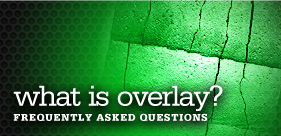FAQs
Frequently Asked QuestionsAre there supposed to be cracks in my overlay plate?
Yes. HS650 and HS750 Chromium-carbide overlay plate is a bi-metallic product. These two different metals are bonded at high temperature. As they cool, stress builds in the plate and stress-relief cracks begin to form. When we straighten the plate (by rolling), we make sure that we relieve as much of this internal stress as possible. These cracks should be perpendicular to the bead direction. They should be spaced 1” to 2” apart. They should not extend into the base metal. Cracks should never run parallel to the overlay weld beads.
How should HardSteel overlay liners be attached?
There are several attachment methods that can be used to attach HardSteel liners:
- Perimeter Welding
The mild steel base plate allows liner plates to be attached by welding around the perimeter of each plate. We recommend that you protect those welds by hardfacing over the attachment weld. HardSteel offers chromium-carbide wire and/or electrodes to provide this protection. - Studs
HardSteel can provide welded studs for easy field installation. Studs are available in a variety of sizes and are arc welded using state-of-the-art technology.
Countersunk bolts – HardSteel first cuts a through-hole with either programmable plasma or waterjet. Each hole is then individually countersunk and checked for fit. The finished liner will have excellent holding strength without interfering with material flow. - Hardfaced Countersunk Bolts
To avoid the possibility of premature wear, HardSteel can install and hardface countersunk bolts, provide hardfaced bolts for you to use in your installation or provide wire and/or electrodes that can be used to hardface over the bolts once installation is complete. - Plug Welding
When possible, plug welding should be done from the back side. This prevents cutting through the overlay layer and creating a premature wear spot. When necessary, plug –welding can be done from the top by cutting a hole in the HardSteel overlay liner and welding the mild steel base plate to the backer plate. The hole should then be filled and hardfaced. HardSteel can provide our hardfacing wire and/or rods to make sure that the integrity of the liner is not compromised
How do I weld HardSteel HS650 or HS750?
The base plate for both products is mild steel and can be welded to other carbon steel with 7018 or 8018. No preheating us required. All surfaces should be clean and free of foreign substances and debris.
How should I attach lifting lugs to the overlay side of plates?
It is NOT recommended. Lifting lugs may be attached to the mild steel side only. Welds to the chromium-carbide overlay are not structural and injury may occur.
Can I drill a hole in the HardSteel overlay plate?
No. The chromium-carbide layer on HS650 and HS750 is not drillable or machineable. When holes are required, they may be cut with plasma, cut with a waterjet, or arc-gouged.
What sizes are available?
The standard size for all HS650 and HS750 plates is 5’ X 10’ (1.52m X 3.05m). However, when bordering our plates, we cut them as wide and as long as possible to allow an extra inch or two to help our customers when nesting parts to cut out. Overlay plate can be spliced. By bonding two plates together, HardSteel can provide any size plate our customers need. When you need to cut parts that are more than 60” wide, please give us a call to see if larger plates would save money by reducing material waste
Can HardSteel overlay plate be formed?
Yes. Overlay is often formed by press-breaking, particularly when used in cone liners and some chutes. Roll forming is used for chutes, crusher liners, dozer blade liners, etc. Usually, forming is done with the overlay to the “inside”. If overlay is formed with the wear surface to the outside, the stress relief cracks will open. It may be necessary to fill the cracks. HardSteel provides the products to do so.
Is there anything else I should know about handling HardSteel overlay plate?
Yes. Plate dogs are not recommended for use in handling overlay plate. HardSteel overlay plate is so hard that the teeth on the plate dog cannot bite into the plate. If it is necessary to use plate dogs, make certain that the teeth bite into the mild steel side.
Questions?

Physical Address:
702 Bear Creek Cutoff Rd.
Tuscaloosa, AL 35405
Mailing Address:
PO Box 2266
Tuscaloosa, AL 35403
Office: 205.343.9100
Fax: 205.343.0073


